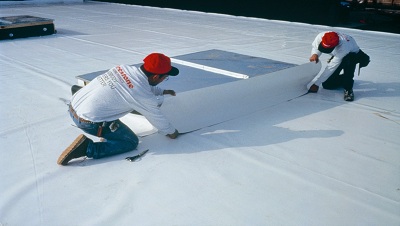Membrane roofing is a type of roofing system for buildings and tanks. It is used on flat or nearly flat roofs to prevent leaks and move water off the roof. Membrane roofs are most commonly made from synthetic rubber, thermoplastic (PVC or similar material), or modified bitumen. Membrane roofs are most commonly used in commercial application, though they are becoming increasingly more common in residential application.
Membrane Roof System
Types of Membrane Roof System
Synthetic Rubber (Thermoses)
This type of membrane roof is made of large, flat pieces of synthetic rubber or similar materials. These pieces are bonded together at the seams to form one continuous membrane. The finished roof’s thickness is usually between 30 and 60 mils(thousandths of an inch) (0.75 mm to 1.50 mm). Other types of related materials are CSPE, CR, and ECR.

Thermoplastic Membrane
This is similar to synthetic rubber, but the seams are typically heat-fused (welded) to form a continuous membrane. The ‘lap’ seams can also be fused with solvents instead of heat, and can be as strong as the rest of the membrane. Other related materials are CPA, CPE, EIP, NBP, PIB, and TPO.

Modified Bitumen
This type of roofing is an evolution of asphalt roofing. It is made from asphalt and a variety of rubber modifiers and solvents. There are several ways of connecting pieces of this material. In a heat application process the seams are heated to melt the asphalt together and create a seal. There is also hot-mopped application, similar to how conventional built-up roofs are installed. Cold-applied adhesives and self-adhesive membranes are two of the more recent options. This material is also referred to as APP, SBS, and SEBS.





